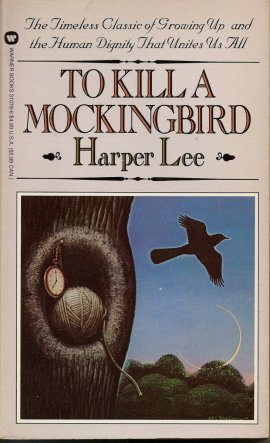 This is going to be a bit of a scattershot review as I had somewhat mixed feelings about this book that managed to resolve themselves by the time I finished.
This is going to be a bit of a scattershot review as I had somewhat mixed feelings about this book that managed to resolve themselves by the time I finished.
Hesitations first: I have been reading Margaret Laurence’s The Diviners for a class that I am a part of, and these two novels began to blend into each other. They both deal with small communities – Maycomb County in Lee’s, Manawaka in Laurence’s, have young female narrators growing up (only for a part of Laurence’s though), have a wide range of characters from various social classes, and feature conflicts that pit the different classes against each other. I’m not sure this was a good conflation, so I stopped reading Laurence’s book to finish this one.
I found it hard to get into the novel for a good 100 pages or so. The folksy/Southern tone of the novel was somewhat off-putting. Maybe it is because I slogged through William Faulkner’s The Sound and the Fury last summer or Zora Neale Hurston’s Their Eyes Were Watching God a year ago, but somehow this felt a little stale and trodden. This is a totally unfair critique though, and I admit that. Once I managed to get into it, it really took off and felt less like Tom Sawyer and more like Huck Finn (to make another American lit analogy).
Hesitations aside, what I liked: the issue of racism at the heart of the novel felt, at first and mistakenly so, out of touch. As a 21st century reader in Canada, I’d like to think that such issues have been long dead in this northern country, or, even better, that they never did happen here. This is utter nonsense. Canada, in its 200 + years of history (dating back to European settlement) , has been just as racist as the Americans have (and, in many ways, still is although we tend to view the indigenous peoples as problems instead of African-Canadians). In another light, our country has a worse history because it has tried to cover this past up with copious amounts of official apologies (many of them far too late in coming) and a general myth that, somehow, we were/are more civilized than our southern neighbours. Again, not true. This book was a good wake-up call to issues of race/ethnicity that still plague Canada today. Just look at some of the comment boards on CBC or the Globe and Mail’s stories on Idle No More.
Yesterday, in lecture for the above-mentioned class, the professor mentioned that novels, because of their length, are more invested in character and time than short fiction. I heartily agree after finishing this book. Scout, the narrator of the novel, really grew on me and Lee’s careful depictions of the changing relationships in the family between Atticus, the single father-lawyer, Jem, his son, Calpurnia, the black cook, Aunt Alexandra, and Scout are delightful to read. These are living breathing characters that felt more like companions that “imaginary” people in a book. I can see why this book was a big hit when it was released and continues to be taught at the elementary and high school levels. Lee has some amazing passages and sequences along with a stellar cast of characters.
Lastly, the novel’s structure is worth commenting on. Pay close attention to the first page or two as Lee comes full circle near the end. She caught me off-guard and I was genuinely pleased to see that kind of narrative cohesiveness. It won a Pulitzer Prize and rightly so. This is a rich novel that has a deceivingly complex narrative structure (not unlike The Diviners).
I would heartily recommend this book to any reader and encourage them to get through the slower sections that are ultimately necessary for the novel’s conclusion.
Lee, Harper. To Kill a Mockingbird. New York: Warner Books, 1960. Print.